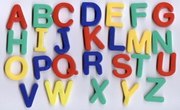Variant vowels are defined as the group of letters that produce the same vowel sounds. In other words, the numerous grouping of letters that all provide the long "a" sound are considered to be variant vowels. Teaching students to read often involves helping them understand that certain groups of letters make the same sounds as other groups of letters.
What Is a Variant Vowel?
For teachers who teach reading, phonics and the basics of language, understanding how to communicate variant vowels to students is critical. The variant vowels definition is a good place to start. While students don't necessary need to know the term "variant vowels", they do need to understand the concept itself. Variant vowels are groupings of letters that produce the same vowel sounds.
One example is the way that "a," "ai," "ay" and "a_e" can all produce the "long a" sound in a different word. These are called variant vowels. Understanding that sometimes letters make the same sounds as other letters is critical to developing reading and writing skills. This term helps to explain why some words are spelled differently but rhyme, such as "neighbor" and "way". These words have variant vowels that perform the same activity.
Variant vowels are one of the things that makes learning English very challenging for nonnative speakers. There are not many other Indo-European-derived languages that have variants in spelling that produce the same vowel sounds. This along with the many contradictions in the language's structure and pronunciation can make it confusing to learn.
What Are Key Terms When Teaching Vowels?
Vowel sounds are notoriously tricky to teach children and much trickier than consonant sounds. There are several reasons for this. Consonants produce definitive sounds that are easily attached to words and are felt more forcefully in the mouth. Vowels on the other hand often sound like one another, and in many cases must be combined with other letters to do the work of producing a sound.
Educators have found that once children are able to hear and identify the beginning and ending sounds of words, they are generally ready to learn about vowel sounds, including variant vowels. Children's made up spelling is also a great way to assess what they are hearing. Often young children will leave out vowels entirely, such as writing "CT" for "CAT." However when they place something there, even if the letter is incorrect, it's generally a signal that they understand that something comes between C and T and are ready to learn about vowel sounds.
How Do You Teach Students About Short Vowel Sounds?
Teaching vowels should be divided into two stages for the best comprehension. The first step is to teach students about short vowel sounds. Short vowel sounds are easier to master than long vowel sounds in almost every case. Words containing short vowel sounds are most consistent in spelling, making it a good jumping off point for young learners.
Starting with word families is an excellent choice for teaching children about short vowel sounds. Showing them words that are in the same family because of shared vowel sounds, such as "rat," "cat," "mat," "pat" and "bat" can help them understand that the words that sound the same are often spelled the same way. This also helps them to recognize word families when reading and can help them begin to sound out words more easily on their own.
Educators suggest introducing word families one at a time. Once the child is comfortable identifying the words that belong to one family, you can move on and introduce another word family. Once students get comfortable with different word families and can begin to identify them, you can move on to more complex vowel sounds.
How Do You Teach Students About Variant Vowel Sounds?
A good place to start teaching about variant vowel sounds is by beginning to listen to words with long vowel sounds. Hearing different words with long vowel sounds and then looking at them written down can help to get learners accustomed to the fact that different letter combinations can produce the same sounds. This is called a vowel digraph.
A long vowel is a vowel that says its own name. In a word like "go" for example or "taken" the vowels at the end of the word or the end of the syllable are long vowels. Sometimes a vowel is paired with a silent "e." In those cases, the vowel says it's own name again. Another rule of thumb is that sometimes two vowels are paired together in a word, as is the case with "boat," "meal" and "hair." In these cases, the first vowel is always a long vowel, and the second vowel is always a short vowel.
By teaching these rules, you can begin to teach variant vowel activity. This is a good time to explain to learners that the vowel sounds produced when two vowels like "a" and "i" come together can also be produced when vowels like "e" and "i" or "a" and "y" are placed together. Students will then begin to understand that there are a wealth of sounds that vowels help to create, and the function of each one is not completely static.
What Is a Diphthong?
Related to a digraph is a diphthong. A digraph is when two vowels are placed next to each other to produce the long sound of the first vowel. A diphthong is when two vowels are placed together and yield a new sound. An example is the "ou" together in "cloud," which creates the "ow" sound that doesn't exist within the typical constraints of "o" or "u" usage.
The diphthong can be confusing to new readers and spellers. In fact, the word diphthong may be advisable to omit altogether when teaching this rule. The important thing is that students know that when they see two vowels together, the letters behave differently than they would were they on their own.
This is also the case when teaching the "bossy r" rule. Anytime a vowel in a single syllable precedes an "r," the vowel is changed by the "r," and is no longer in its short or long form. Instead, the presence of the "r" forces the vowel to make a new sound. In this way the "r" "bosses" the vowel, forcing it to change its usual function.
Is There a Variant Vowels List?
For teachers who are hoping to help educate their students about variant vowels, making a list to follow is a good way to make sure all variant vowel combinations are covered. Vowel combinations like "ai" and "ay" and "ei" are one set of variant vowels that are controlled by the letters that are around them to produce the sound of "i." Vowel sounds produced by these letters may sound similar when spoken but are spelled differently, which is critical for students to learn.
In other words, the sounds made by "oo" can be produced by the letters "ou" or "eu." In still other scenarios, the vowel sound of "a" may be produced with the vowel combinations of "ae," "ay," "ey" and "ai." In all cases, teaching children the significance of the surrounding letters in a word and how they are brought to bear on the pronunciation of different vowels.
The variant vowels list of vowel sounds that can be produced with multiple spellings is: aw, au, ay, eu, ei, ew, oi, oo (both long and short), ou, ow(both long and short) and oy.
Related Articles
References
Writer Bio
Ashley Friedman is a freelance writer with experience writing about education for a variety of organizations and educational institutions as well as online media sites. She has written for Pearson Education, The University of Miami, The New York City Teaching Fellows, New Visions for Public Schools, and a number of independent secondary schools. She lives in Los Angeles.










